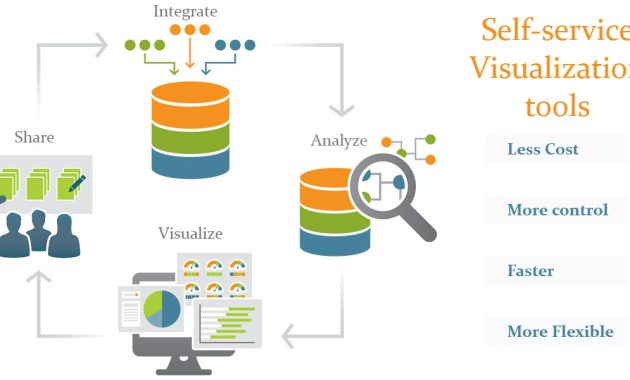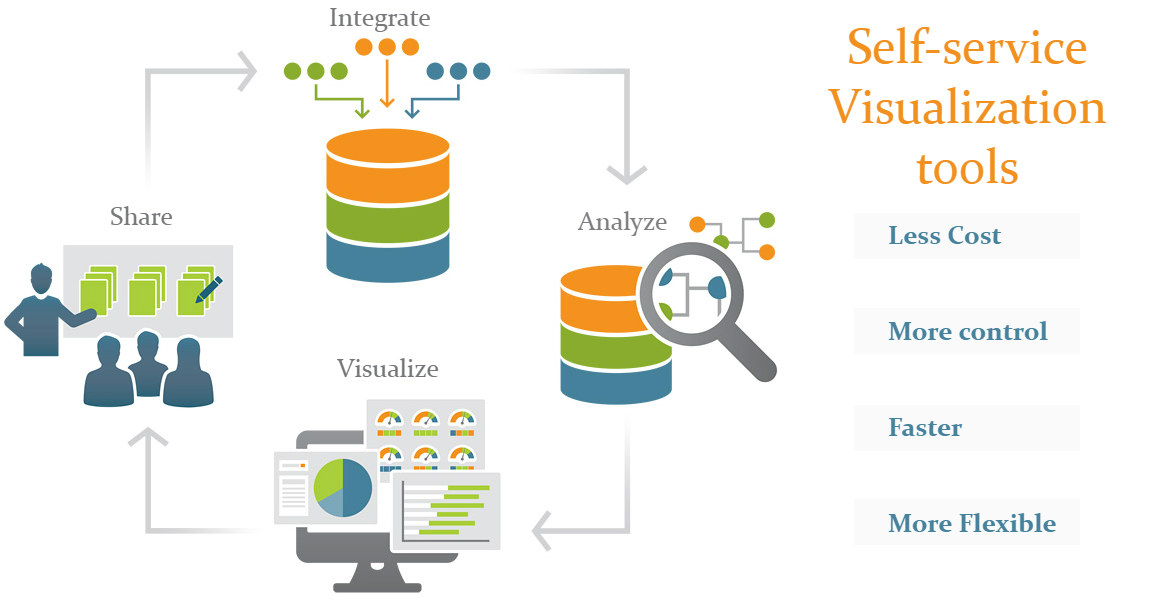
Self-Service Business Intelligence Software: A Paradigm Shift
In today’s data-saturated landscape, the ability to extract actionable insights quickly is paramount. Organizations are increasingly turning to self-service business intelligence (BI) software to empower their employees. This shift moves away from relying solely on IT or specialized data teams. It enables individuals across departments to access, analyze, and visualize data. This empowers them to make informed decisions. A key benefit of this approach is its ability to reduce silos.
Traditional business intelligence often involves complex processes. Data is pulled from various sources, cleaned, transformed, and analyzed. This process can be time-consuming, requiring specialized skills and often creating bottlenecks. Self-service BI software streamlines this process. It provides user-friendly interfaces, pre-built dashboards, and drag-and-drop functionality. This allows users to explore data independently and generate their own reports. This ultimately leads to faster insights and improved decision-making.
One of the most significant advantages of self-service BI software is its ability to dismantle data silos. Silos are isolated data repositories. These impede collaboration and limit the flow of information across departments. By providing a centralized platform for data access and analysis, self-service BI software breaks down these barriers. It enables different teams to share data, collaborate on projects, and gain a holistic view of the business. This fosters a culture of data-driven decision-making across the entire organization.
The Silo Problem: A Barrier to Data-Driven Success
Data silos are a common problem in many organizations. They often arise from departmental structures, legacy systems, and a lack of data integration. Each department may have its own data sources, tools, and reporting processes. This leads to fragmented information, inconsistent data, and a lack of a unified view of the business. This fragmentation hinders collaboration, slows down decision-making, and limits the ability to identify opportunities and risks.
The consequences of data silos can be significant. They can lead to:
- Inefficient Operations: Duplication of effort, redundant data entry, and a lack of coordination across departments.
- Poor Decision-Making: Decisions based on incomplete or inaccurate information, leading to missed opportunities and costly mistakes.
- Reduced Agility: Difficulty adapting to changing market conditions and responding to customer needs.
- Lack of Innovation: Limited ability to identify trends, patterns, and insights that can drive innovation and growth.
Addressing the silo problem is crucial for organizations that want to become data-driven. This requires a combination of technology, processes, and a cultural shift. Self-service BI software plays a pivotal role in this transformation.
How Self-Service BI Software Reduces Silos
Self-service BI software offers several key features that directly address the silo problem:
- Data Integration: These platforms connect to various data sources. This includes databases, spreadsheets, cloud services, and other applications. They consolidate data from disparate sources into a single, unified view.
- Centralized Data Access: Users across departments can access data through a single platform. This eliminates the need to request data from IT or other teams. This streamlines access and reduces delays.
- Data Governance and Security: Robust data governance features ensure data quality, security, and compliance. This minimizes the risk of data breaches and ensures data is used responsibly.
- Collaboration Tools: Many self-service BI software solutions offer collaboration features. These include data sharing, commenting, and version control. This facilitates teamwork and knowledge sharing across departments.
- User-Friendly Interface: Intuitive interfaces and drag-and-drop functionality empower users. This allows them to explore data, create visualizations, and generate reports without technical expertise.
By providing these features, self-service BI software enables organizations to break down data silos. It allows them to foster a more collaborative, data-driven culture. This leads to better decision-making and improved business outcomes.
Key Benefits of Self-Service Business Intelligence
Beyond reducing silos, self-service BI software offers a range of other benefits:
- Faster Time to Insights: Users can quickly access and analyze data without relying on IT or data specialists.
- Improved Decision-Making: Data-driven insights empower users to make more informed decisions.
- Increased Efficiency: Automation and self-service capabilities reduce manual tasks and streamline reporting processes.
- Enhanced Collaboration: Centralized data access and collaboration tools foster teamwork and knowledge sharing.
- Cost Savings: Reduced reliance on specialized resources and streamlined processes can lead to significant cost savings.
- Increased Agility: Businesses can adapt to changing market conditions more quickly.
Choosing the Right Self-Service BI Software
Selecting the right self-service BI software solution is crucial for success. Consider the following factors when evaluating different options:
- Ease of Use: The software should have an intuitive interface and drag-and-drop functionality. This makes it easy for users of all skill levels to learn and use.
- Data Connectivity: Ensure the software can connect to all your data sources. These include databases, spreadsheets, cloud services, and other applications.
- Data Visualization Capabilities: The software should offer a wide range of visualization options. This allows users to present data in a clear and compelling way.
- Collaboration Features: Look for features that facilitate collaboration. These include data sharing, commenting, and version control.
- Security and Governance: Choose a solution that offers robust security and data governance features. This ensures data is protected and used responsibly.
- Scalability: The software should be able to scale to meet your organization’s growing data needs.
- Cost: Evaluate the pricing models and ensure the software fits your budget.
- Training and Support: Consider the availability of training resources and technical support. This helps users get the most out of the software.
Implementing Self-Service BI: Best Practices
Successfully implementing self-service BI software requires a well-defined strategy. Here are some best practices:
- Define Clear Goals: Identify your business objectives and how self-service BI can help you achieve them.
- Choose the Right Software: Select a solution that meets your specific needs and requirements.
- Provide Training and Support: Ensure users have the skills and knowledge to use the software effectively.
- Establish Data Governance Policies: Implement policies to ensure data quality, security, and compliance.
- Promote a Data-Driven Culture: Encourage data sharing, collaboration, and decision-making based on data insights.
- Start Small and Scale Gradually: Begin with a pilot project and gradually expand the use of self-service BI across the organization.
- Monitor and Evaluate: Track key metrics and assess the impact of self-service BI on your business.
Real-World Examples: Self-Service BI in Action
Many organizations are successfully using self-service BI software to break down silos and improve decision-making. Here are a few examples:
Example 1: Retail Company. A retail company used self-service BI to integrate data from its point-of-sale systems, e-commerce platform, and customer relationship management (CRM) system. This provided a unified view of customer behavior, sales trends, and inventory levels. The marketing team could then analyze customer data. They could personalize marketing campaigns and improve customer engagement. The operations team optimized inventory management. This reduced stockouts and improved overall efficiency. This resulted in increased sales and improved customer satisfaction.
Example 2: Healthcare Provider. A healthcare provider implemented self-service BI to analyze patient data. They could identify trends in patient outcomes, track the effectiveness of treatments, and improve patient care. Doctors and nurses could access real-time data on patient health. They could make more informed decisions about treatment plans. This led to improved patient outcomes and reduced healthcare costs.
Example 3: Manufacturing Company. A manufacturing company used self-service BI to integrate data from its production systems, supply chain, and sales data. This provided a holistic view of the manufacturing process. They could then identify bottlenecks, optimize production schedules, and improve efficiency. The sales team could use the data. They could forecast demand more accurately. This improved supply chain management and reduced costs. This led to increased profitability and improved customer satisfaction.
The Future of Self-Service BI: Trends and Innovations
The self-service BI landscape is constantly evolving. Several trends are shaping the future of this technology:
- Artificial Intelligence (AI) and Machine Learning (ML): AI and ML are being integrated into self-service BI platforms. This provides users with automated insights, predictive analytics, and data-driven recommendations.
- Cloud-Based Solutions: Cloud-based self-service BI platforms are becoming increasingly popular. They offer scalability, flexibility, and cost-effectiveness.
- Mobile BI: Mobile BI allows users to access and analyze data on their smartphones and tablets. This enables them to make decisions on the go.
- Data Storytelling: Data storytelling is the process of using data to create compelling narratives. This helps users communicate their findings more effectively.
- Augmented Analytics: Augmented analytics uses AI and ML to automate data preparation, insight discovery, and data visualization. This makes self-service BI more accessible to a wider audience.
These trends will continue to drive innovation and shape the future of self-service BI. Organizations that embrace these trends will be well-positioned to leverage the power of data. They will make more informed decisions and gain a competitive advantage.
Conclusion: Embracing Data Democratization
Self-service BI software is a powerful tool for breaking down data silos. It empowers employees to access, analyze, and visualize data. This fosters a culture of data-driven decision-making. By implementing self-service BI, organizations can improve efficiency, enhance collaboration, and gain a competitive edge. This is achieved by embracing the principles of data democratization. This allows data to be accessible to everyone, not just specialists. It is an essential investment for any organization seeking to thrive in today’s data-driven world. Consider your needs. Evaluate the available options. Implement a well-defined strategy. You can unlock the full potential of your data. You can drive better business outcomes.
[See also: The Rise of Data Democratization, Data Governance Best Practices for Self-Service BI, Choosing the Right BI Platform for Your Business]

